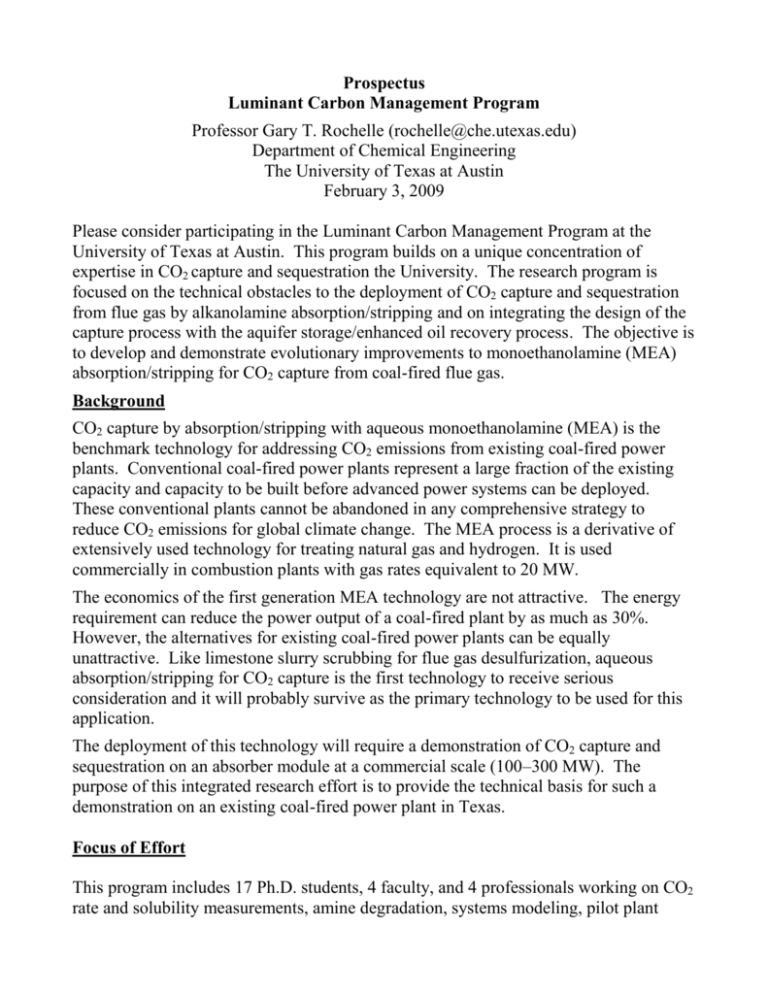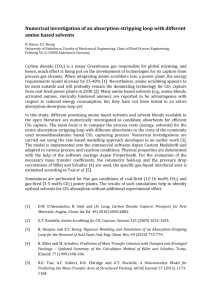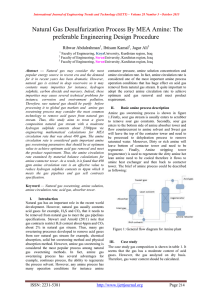Prospectus_Luminant CMP_2_3_09
advertisement

Prospectus Luminant Carbon Management Program Professor Gary T. Rochelle (rochelle@che.utexas.edu) Department of Chemical Engineering The University of Texas at Austin February 3, 2009 Please consider participating in the Luminant Carbon Management Program at the University of Texas at Austin. This program builds on a unique concentration of expertise in CO2 capture and sequestration the University. The research program is focused on the technical obstacles to the deployment of CO2 capture and sequestration from flue gas by alkanolamine absorption/stripping and on integrating the design of the capture process with the aquifer storage/enhanced oil recovery process. The objective is to develop and demonstrate evolutionary improvements to monoethanolamine (MEA) absorption/stripping for CO2 capture from coal-fired flue gas. Background CO2 capture by absorption/stripping with aqueous monoethanolamine (MEA) is the benchmark technology for addressing CO2 emissions from existing coal-fired power plants. Conventional coal-fired power plants represent a large fraction of the existing capacity and capacity to be built before advanced power systems can be deployed. These conventional plants cannot be abandoned in any comprehensive strategy to reduce CO2 emissions for global climate change. The MEA process is a derivative of extensively used technology for treating natural gas and hydrogen. It is used commercially in combustion plants with gas rates equivalent to 20 MW. The economics of the first generation MEA technology are not attractive. The energy requirement can reduce the power output of a coal-fired plant by as much as 30%. However, the alternatives for existing coal-fired power plants can be equally unattractive. Like limestone slurry scrubbing for flue gas desulfurization, aqueous absorption/stripping for CO2 capture is the first technology to receive serious consideration and it will probably survive as the primary technology to be used for this application. The deployment of this technology will require a demonstration of CO2 capture and sequestration on an absorber module at a commercial scale (100–300 MW). The purpose of this integrated research effort is to provide the technical basis for such a demonstration on an existing coal-fired power plant in Texas. Focus of Effort This program includes 17 Ph.D. students, 4 faculty, and 4 professionals working on CO2 rate and solubility measurements, amine degradation, systems modeling, pilot plant testing, sequestration modeling, and policy/systems analysis. The effort is currently funded by $500,000/yr from Luminant, and by more than $500,000/yr from 24 industrial sponsors in the Luminant Carbon Management Program and other affiliated activities including 8 process suppliers (Alstom Power, Babcock & Wilcox, Cansolv, Fluor, IFP, Shell Global Solutions, Mitsubishi Heavy Industries, URS, Siemens), 10 users (LS Power, Southern Company, RWE npower, E.ON, NRG, Eastman, Aramco, Chevron, BP, ConocoPhillips), and 5 others (AspenTech, Dow, Huntsman Chemical, CSIRO, Battelle). 1. A wetted wall column is being used to obtain CO2 kinetics and solubility at absorber and stripper conditions. Ross Dugas is completing a comprehensive study of MEA, piperazine (PZ) and MEA/PZ blends. Future work by Xi Chen will include studies of piperazine derivatives, diglycolamine, ethylenediamine, and hindered amines. 2. Thermodynamic measurements are being performed to support rigorous predictions by the electrolyte/NRTL model. We use a sparged reactor to measure CO2 solubility and amine volatility at absorber conditions with a hot gas FTIR. Solutions are speciated by H1 and C13 NMR at 25 to 60oC. Liquid heat capacity is measured with a differential scanning calorimeter. Marcus Hilliard (2008) has published a complete set of data for MEA/PZ/K2CO3 systems. Thu Nguyen has initiated a study of amine volatility in MDEA/PZ, concentrated PZ and other amine systems. 3. Andrew Sexton (2008) has completed measurements of the oxidative degradation of MEA by the evolution of ammonia and aldehydes from a stirred cell reactor with gas phase analysis by the FTIR at 180oC. He is also degrading loaded amine solutions with 7-day experiments in a heavily agitated reactor. The degraded solutions are analyzed by cation and anion chromatography, HPLC, and NMR to determine and quantify degradation products including organic acids, amino acids, and amides. Stephanie Freeman is using these methods to measure oxidation of piperazine. Alex Voice will apply all of these methods to other amine solvents including hindered amines such as aminomethylpropanol (AMP), tertiary amines such as methyldiethanolamine (MDEA), and polyamines such as ethylenediamine. 4. Thermal Degradation of amine solutions is being quantified by Jason Davis. Solutions loaded with CO2 are degraded in sealed bombs in oven at 100–150oC. The degradation products are analyzed by gas, liquid, and ion liquid chromatography. The degradation products are identified by mass spectrometry. This work is critical to setting the maximum stripper temperature for solvents containing MEA and other amines. Fred Closmann is applying these methods to the thermal degradation of MDEA/PZ. 5. Solvent reclaiming may be possible by a combination of evaporation and phase separation. Qing Xu (2008) has completed a study of potassium sulfate crystallization from MEA and PZ solvents to provide for simultaneous removal of SO2 and CO2. She is developing a new experiment to measure VLE at the high T of thermal reclaiming. 6. Rigorous thermodynamic models of the data are correlated with the AspenPlus® Electrolyte-NRTL model. Marcus Hilliard (2008) completed rigorous thermodynamic models for MEA, piperazine, MEA/PZ, and PZ/K2CO3. Thu Nguyen will update these models for MDEA/PZ and concentrated piperazine. 7. Rigorous stripper process models are being developed to predict energy requirements. David Van Wagener is developing rate-based models for MEA, piperazine, MEA/PZ, and K2CO3/PZ solvents. He will be developing methods to simulate stripping mass transfer with flashing and in the reboiler. These methods will be applied to the evaluation and design of advanced stripper configurations such multistage flashing and double matrix that will reduce net energy requirement. 9. Rigorous absorber models are being developed to represent and extrapolate pilot plant data. Eric Chen (2007) developed an absorber model of promoted potassium carbonate using Ratesep™ in AspenPlus®. Jorge Plaza is using this model to evaluate the advantages of intercooling. He will be developing rigorous absorber models for MEA, PZ, and MEA/PZ solvents. Peter Frailie will develop a rigorous absorber model for MDEA/PZ. 10. System models are being developed for optimization and control. Sepideh Ziaii will develop an integrated model of MEA absorption/stripping in Ratesep™ and a dynamic model in Aspen Custom Modeler® to study optimization and control of advanced stripper configurations. Her specific objective is to develop a control system design that will permit rapid shutdown and start-up to free power capacity to meet peak loads. 11. A carefully controlled pilot plant facility has been constructed and used to provide quantitative screening of contactor alternatives and to demonstrate important process concepts. This facility is currently being used to test concentrated piperazine. It will be used to test other advanced solvents and innovative stripper configurations. It is available for proprietary testing by our industrial sponsors. 12. The wetted area of packing alternatives is being measured by CO2 absorption in 0.1 M NaOH in a separate 16.8-inch air-water column. Bob Tsai is using the small wetted wall column to develop solvent systems with viscosity and surface tension additives. He will measure the effects of surface tension and viscosity on effective wetted area with structured packing in the 16.8-inch column. Chao Wang will expand these measurements to random packing. Xi Chen has initiated measurements of foaming in amine solutions. 13. The potential for sequestration will be evaluated by the Bureau of Economic Geology (Susan Hovorka) for potential sites in Texas for a 20 MW prototype and 200 MW demonstration of aqueous absorption/stripping for CO2 capture. This evaluation will consider both geological sequestration and enhanced oil recovery. 14. The security of CO2 storage is being simulated by the Joint Industry Project for Geological CO2 Storage in the Center for Petroleum and Geosystems Engineering (Prof. Steve Bryant). This work is quantifying the likelihood of CO2 reaching shallow aquifers and the surface, particularly from “permanent” forms of storage. The modeling effort will be expanded to consider the alternate strategies for secure CO2 storage at sites to be considered for the 200 MW demonstration of CO2 capture. 15. The public policy implications of this work will be amplified by Stuart Cohen, a mechanical engineering Ph.D. student supervised by Prof. Michael Webber. This work will address the possibilities of turning the CO2 capture system on and off to provide peak load capacity and optimize the economics in an unregulated environment. Stuart will also address the policy interactions of sequestration and CO2 capture. Please consider participating in this research program by providing $25,000 for 2009. If you wish formal participation, you may execute the attached Memorandum of Agreement. We will then provide you with an invoice for payment. You may also implement this support as a gift by sending payment with cover language such as “Enclosed is a grant of $25,000 to support the research effort of Dr. Rochelle in carbon management for the year 2009.” Neither mode of participation includes contractual deliverables. As a courtesy we will provide you with copies of preprints and publications generated by the research and you will be invited to attend semi-annual research review meetings and to contribute to discussions of future work. Our next research review meeting will be in Austin on June 2-3, 2009. There will be a condensed, identical version of this meeting in Trondheim, Norway on June 15, 2009.









